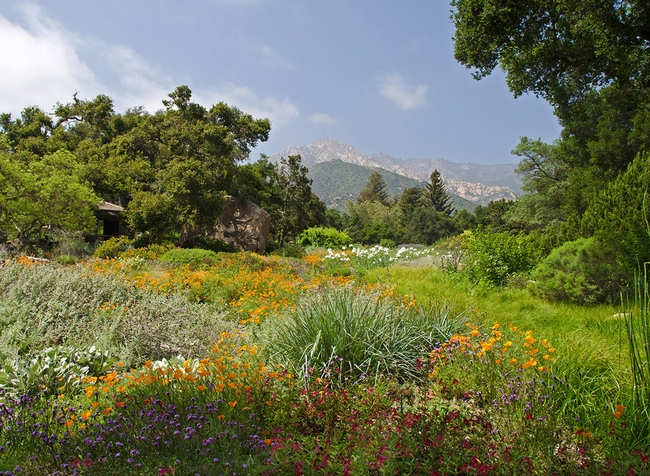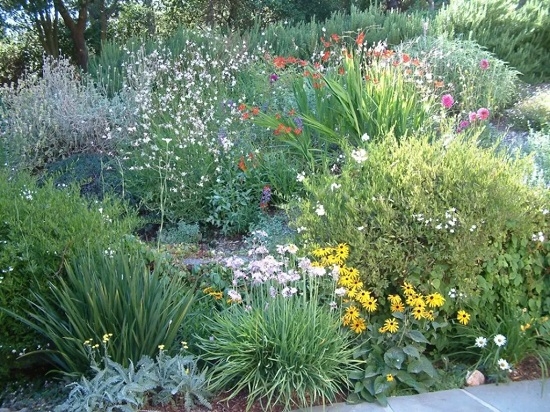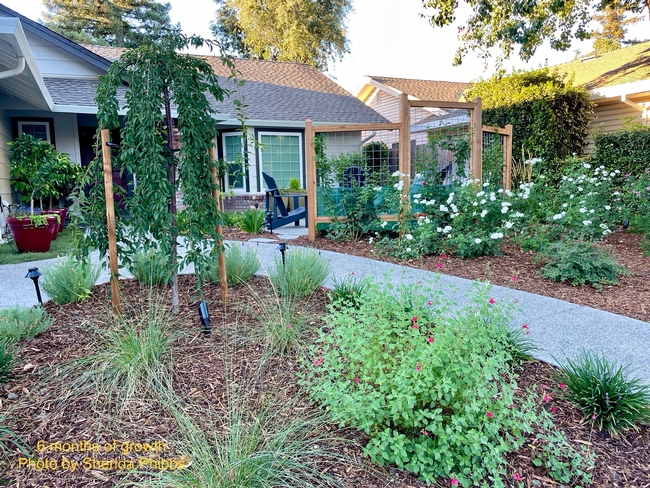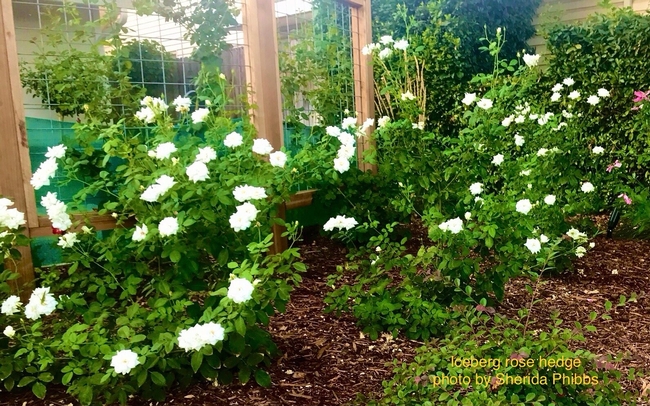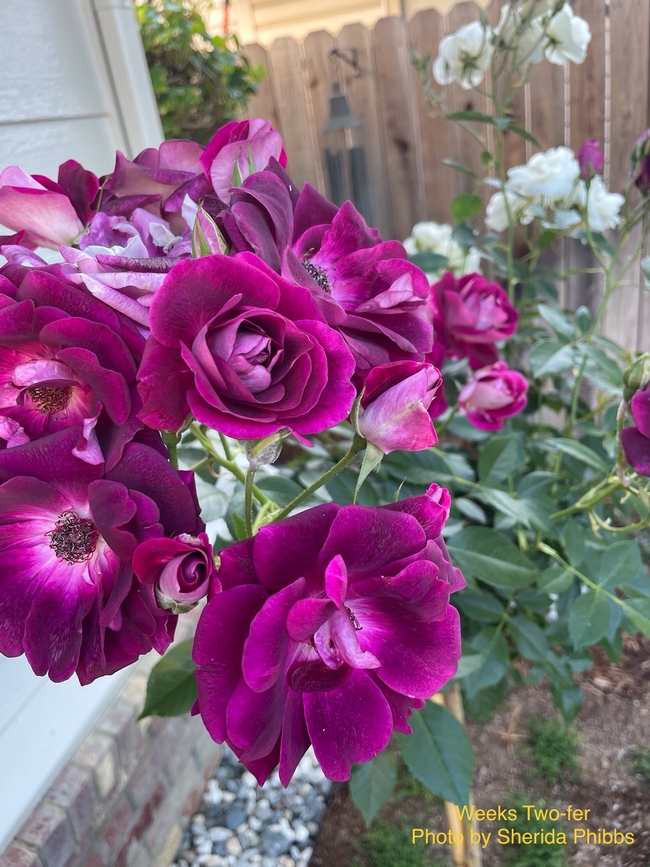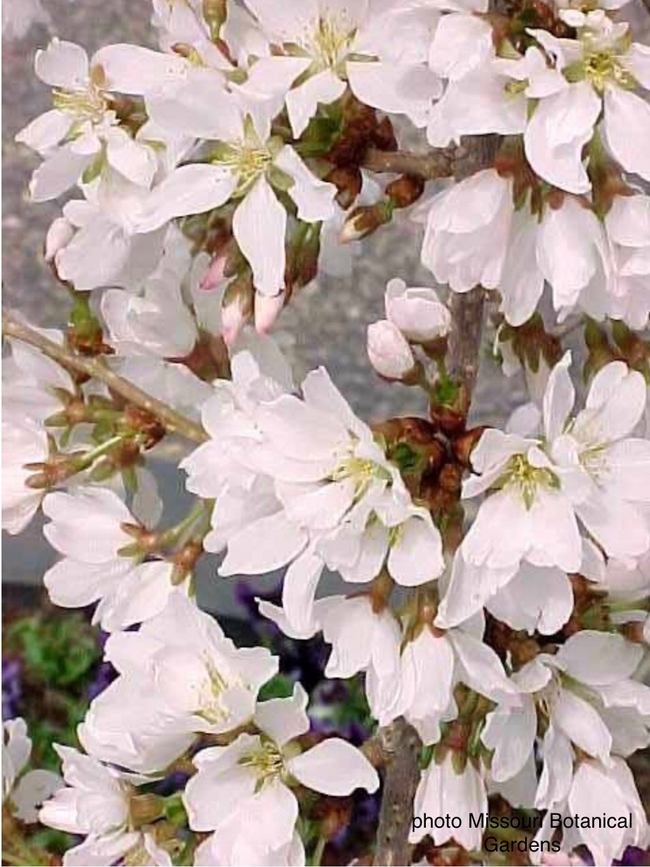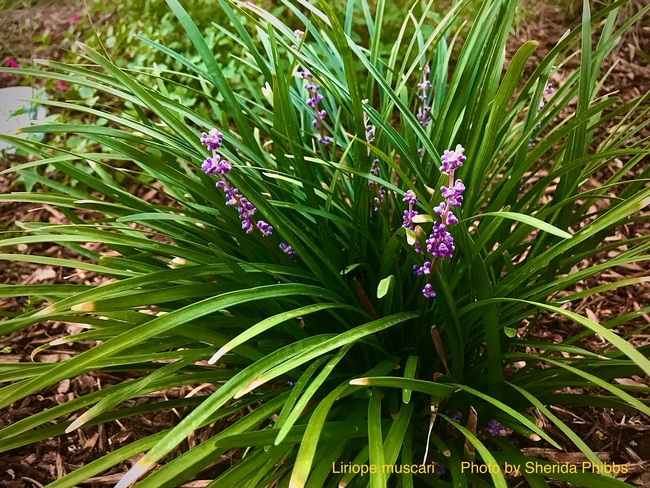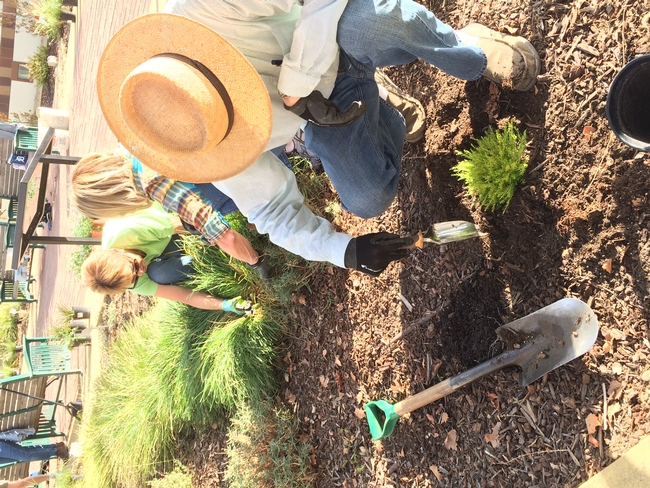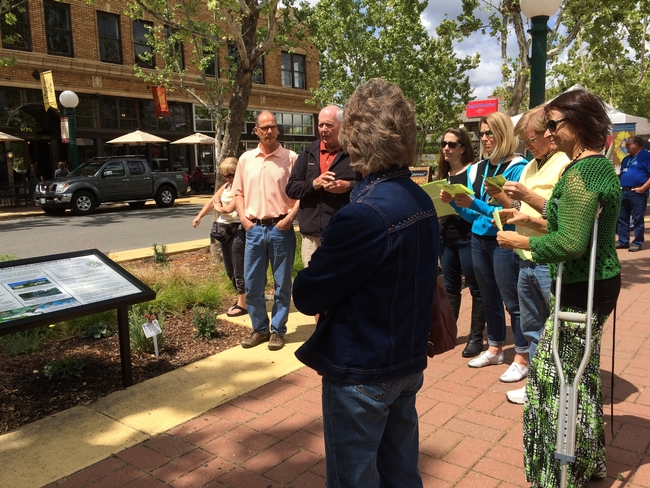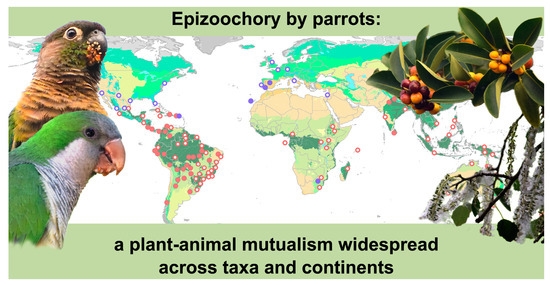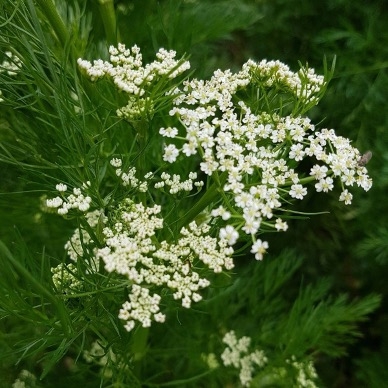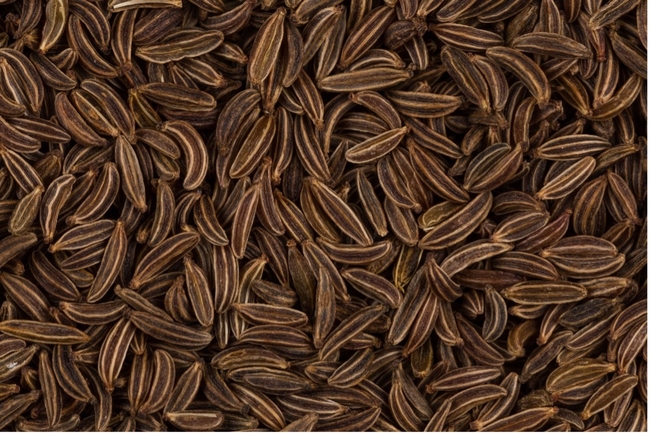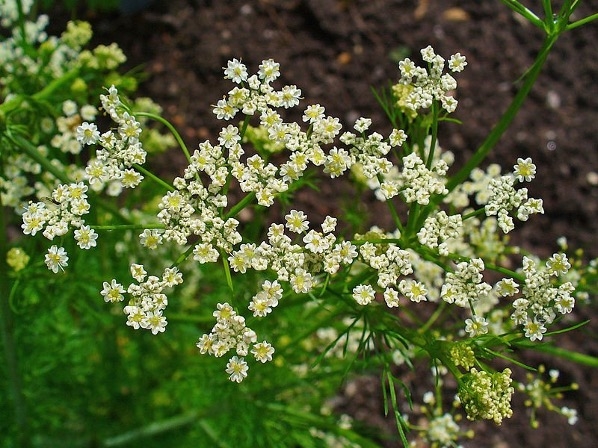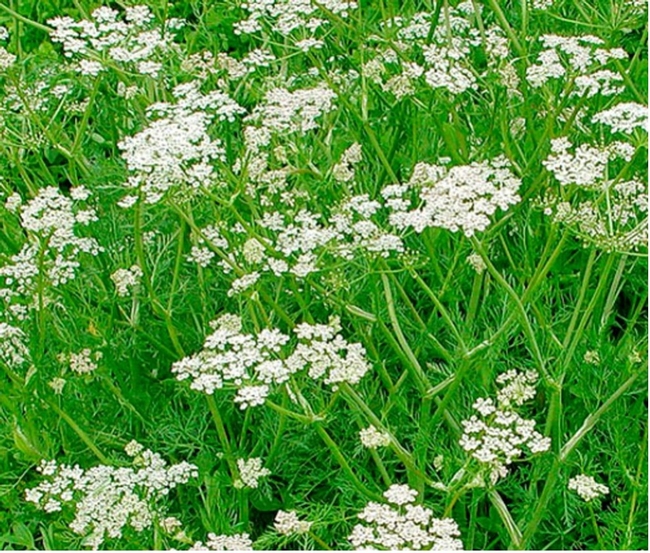- Author: Anne Horelly, Master Gardener
There are lots of reasons to include native plants in your garden. But do you know when the native plant movement began in California and why the use of native plants is so important?
Theodore Payne (1872-1963) is generally considered the father of the native plant movement in California. Mr. Payne was born in England and arrived in New York on June 10, 1893. By July, he had made his way to Southern California where he spent the rest of his life promoting the virtues of California's native plants.
In 1903, Mr. Payne purchased a nursery in Los Angeles. The nursery sold a full range on flowers, trees, vegetables and seeds. By 1905, the Payne Nursery began to specialize in California wild flowers and native plants. A year later, the first catalog of seed offerings was published. Mr. Payne also published Payne's Garden Guide and other catalogs. He collected native plant seeds and introduced over 400 species for cultivation at his nursery.
During his life, Mr. Payne designed several gardens in Southern California using native plants. One of his early gardens, the California Wild Garden in Los Angeles, featured 262 species of California native trees, shrubs and wild flowers. Other gardens and landscape projects include Pomona College, Occidental College, Torrey Pines Park, the Santa Barbara Botanic Garden (shown in the figure below), Exposition Park in Los Angeles and Cal Tech in Pasadena.
In 1960, the Theodore Payne Foundation for Wild Flowers and Native Plants, Inc. was founded. Today known simply as the Theodore Payne Foundation, the non-profit organization continues the work of Mr. Payne through education and inspiration to use native plants. One of the resources the foundation developed is the California Native Plant Library. The library can be searched by botanical name, common name or family name. There are lists of plants by plant type, flower color and water needs. The entries for each plant include information about care and maintenance, and specific uses such as “attracts butterflies” as well as other information.
In Northern California, the push for native plants began in 1965 when a small group of gardeners, nature lovers and plant experts came together in Berkeley to save the Tilden Regional Park's Botanic Garden. The group went on to become the California Native Plant Society (CNPS). Today, there are 36 chapters across the state that advance the CNPS core programs, including conservation, education, gardening, publications, rare plant science and vegetation science.
As Mr. Payne did, CNPS has developed a list of native plants. The current list is an online database called Calscape. The database can be sorted by the common name of the plant, the botanical name of the plant or, for example, the number of butterflies supported by the plant. Filters that can be used to narrow your search include nursery availability, plant type, water and sun needs, special uses, ease of care, and seasonality.
The research done by these organizations confirms that the use of native plants in our gardens and landscapes is beneficial to our environment. These benefits include:
- California has over 6,000 native plant species, subspecies and varieties. Approximately one-third of these are only found in California.
- Once established, native plants use, on average, one-seventh of the water required by non-native plants.
- Native plants have fewer pest problems than non-native plants, reducing the need for pesticides.
- Native plants like the local soil, so soil amendments and fertilizers are not required. Also, native plants are grown where they are sold so they are not transported long distances.
- A garden designed for the mature-size of the plants can require little maintenance once established.
- Native plants have a diversity of colors, forms, textures, and aromas. With a bit of attention to design, you can have flowers year-round.
- Birds, hummingbirds, butterflies and pollinators use native plants for food and shelter.
- Only 10% of our herbivorous insects can eat non-native plants. Our insects provide 90% of the diet for baby birds and they play an important role in decomposition, pollination and pest management.
So try planting California natives. You won't be sorry. See this photo from the Marin Independent Journal for some inspiration:
Watching the transformation of my front landscape over the past six months has been nothing short of exhilarating. Despite the challenges of an exceptionally hot summer, the plants have thrived, slowly acclimating to their new environment. This success underscores the wisdom behind the Master Gardeners' mantra: “Right Plant, Right Place.” Each plant's resilience is a testament to thoughtful selection as well as careful placement and cultural care. If you missed Part One of my landscape transformation journey you could catch up here.
Follow along with me in this article as I share my simple, weekly, 15-minute maintenance routine, summer pruning benefits for select plants, and the significant benefits of choosing the right irrigation controller. I'll also showcase some of the plants I have chosen for my landscape.
The Myth of Maintenance-Free Landscapes
It's a common misconception that a “maintenance-free” landscape exists. Whether it's questions we receive at the Master Gardener Help Desk or posts on social media, a landscape that requires no upkeep is a frequent request. However, the reality is that no landscape is truly maintenance free. Even something as simple as a cement pad needs regular care—removing leaves and debris, managing weeds that sprout through expansion cracks, and more. A gravel bed, too, requires attention.
As I drive through neighborhoods, I admire landscapes that are well-maintained, reflecting the care and effort invested in them. Conversely, it's disheartening to see landscapes where significant time and money were clearly spent, only for them to fall into neglect. I often wonder when I see a neglected California native landscape if the property owner was misled, thinking that California natives are maintenance free. I highly recommend evaluating the time and the funds it will take to maintain the landscape before embarking on a new installation, and researching the chosen plants to become familiar with their upkeep requirements.
Morning Rituals for a Pristine Landscape
In the cool mornings, before the heat of the day sets in, I make it a habit to stroll through my garden at least once a week. This routine allows me to visually inspect my plants, ensuring the irrigation is properly adjusted and any potential pest issues are promptly addressed. I take this time to pluck out any tiny weeds that have surfaced—they're easy to remove when small, before their roots take hold. I also deadhead spent blossoms to encourage new growth and keep the garden looking vibrant. For unwanted insects, a simple hosing off with water usually does the trick.
I carry a lightweight collapsible garden trash container, which makes it easy to gather any debris or leaves that have blown into the landscape and to discard the spent blossoms I deadheaded. My cordless small blower is perfect for quickly clearing the porch and sidewalks. All of this takes less than 15 minutes because I stay on top of it regularly.
Summer Pruning Benefits Select Plants
Various plants in my landscape benefit from a summer pruning. By incorporating summer pruning into your gardening routine, you can enjoy a more vibrant and healthy landscape. Summer pruning reduces the risk of fungal diseases by allowing better airflow through the plants and keeps your garden looking neat and well maintained. Pruning encourages plants to produce new, healthy growth, which can lead to more flowers and a more vigorous appearance.
Summer pruning can be highly beneficial for a variety of plants in your landscape, including salvias, Santa Barbara daisies, lavenders, and creeping thyme ground cover. Here's a more detailed look at the benefits for each:
Salvias – All my salvias grew three times their size after planting. I remove one-third of the size during summer pruning. Pruning salvias after their initial bloom can stimulate a second round of flowering, while regular pruning helps maintain a compact and bushy shape, preventing the plant from becoming too leggy. Removing spent flowers and stems can improve air circulation, reducing the risk of disease.
Santa Barbara Daisies – For the summer pruning, I pruned them back quite a bit. Cutting back spent flowers encourages continuous blooming throughout the summer. Pruning helps manage the plant's spread, keeping it from overtaking other areas of your garden. Regular trimming keeps the plant looking tidy and well maintained.
Lavenders – After they bloom, I cut back the lavenders to 3 inches above the wood. It is important not to allow the plant to become woody. Pruning after flowering encourages the plant to grow more densely, preventing it from becoming woody. Pruning can sometimes lead to a second bloom later in the season. Keeping the plant's shape neat and compact helps it stay healthy and attractive.
Creeping Thyme Ground Cover – Using cordless shears, I run the shears over the top of the ground cover, removing the spent flowers and steams encroaching onto the sidewalk. Pruning helps the thyme spread more evenly and densely, creating a lush ground cover. Regular trimming keeps the stems from becoming too woody and unproductive. Removing spent flowers can encourage more blooms and a longer flowering period.
Maximizing Efficiency with Irrigation Controllers
Incorporating an irrigation controller is a significant time saver and essential for the success of your plants. Let's face it—plants are expensive, and investing in their care is crucial. With a variety of irrigation controllers available, I opted for ones that I could control via my smart phone or tablet. I have two separate controllers—one for the front landscape and one for the back. This setup was more cost-effective than paying for labor to run extensive wiring.
My smart Wi-Fi models automatically adjust to weather conditions and the specific watering needs of my plants. As a bonus, I was able to apply for a rebate from my city since they are water-saving devices. Interestingly, while the controller I selected for the front landscape is highly regarded and came with a hefty price tag, I found the less costly controller in the back landscape to have the most user-friendly app.
If you're considering replacing or installing an irrigation controller, I recommend looking for a smart Wi-Fi model and checking with your local city water department to see if rebates are available.
Curating My Garden: Plant Selections
As a plant lover, I wanted to create a garden that not only thrives in my climate and microclimate but also brings me joy on multiple levels throughout the year. I carefully selected plants that offer beauty, fragrance, movement, and texture, while also attracting and supporting pollinators. There's something magical about watching bees become intoxicated with the lavender or seeing hummingbirds flit among the salvias and other blooms.
Now, I'm excited to share the details of my plant choices with you, both in this article and in the upcoming winter and spring newsletter editions.
Roses - Timeless Beauties: Roses are an essential element of my garden's tapestry. In the expansive landscape of my Lodi country home, I nurtured a collection of approximately 200 roses. However, urban living at my city residence imposes a limit, allowing for only a select few to grace my front and back landscapes. Among these chosen few for the front landscape are one Rosa x odorata 'Mutabilis' (Butterfly Rose), six pristine white Rosa 'Korbin' (Iceberg Rose), three Rosa ‘Wekroalt' Fourth of July climbers, and two rose standards. For all my roses, I deadhead weekly to encourage reblooming and prune in February.
Rosa xodorata ‘Mutabilis', commonly known as the butterfly rose, is a cherished old garden shrub rose with a rich history. It originated in China and was introduced to Europe in the 19th century. It was first introduced to horticulture in 1934. It is a popular choice for gardens due to its floriferous nature and resistance to pests and diseases. I selected to use the ‘Mutabilis' in my landscape as a specimen rose. It's a shrub rose with the mature size of three to six feet in height and a spread of two to five feet. It has a long bloom period from spring through fall and it attracts butterflies. Its clusters of single cupped flowers are slightly fragrant. A shrub in full bloom will display a wide spectrum of color, a living kaleidoscope. It opens in yellow, changing to pink and finally a deep pink. I sourced my specimen from the UC Davis Arboretum. It is an Arboretum All Star.
Rosa ‘Korbin', commonly known as the Iceberg rose, is a popular floribunda rose cultivar. It was developed by Reimer Kordes in Germany in 1958 and is known for its ruffled, double blooms that can reach up to two to four inches in diameter. The flowers bloom from spring through fall. This rose is appreciated for its fragrance and is often used as a hedge or specimen shrub in gardens. It is also noted for attracting butterflies and birds due to its nectar-rich flowers. The Iceberg rose, a result of a cross between the R. ‘Robin Hood' in R. ‘Virgo', is recognized for its upright, well-branched growth habit, reaching heights of three to five feet and widths of two to three feet. It is listed as a UCD Arboretum All Star.
I have three varieties of ‘Korbin'.
- The classic white Iceberg, forming a hedge of six.
- ‘Brilliant Pink Korbin'. I have one specimen in my backyard. This cultivar has deep pink flowers and fades to a light pink.
- Weeks Roses Two-fer Burgundy Iceberg and White Iceberg 36-inch Standard. I have two standards with 2 rose varieties (a Burgundy Iceberg and a White Iceberg) grafted on a 36-inch Dr. Huery rootstock. A rose standard, also known as a tree rose, is a type of rose that is cultivated by grafting one or more rose varieties together to produce a tall plant with long stems. This method combines the best elements of a strong root stock, a tall stem and the desired flower color and production.
Rosa ‘Wekroalt' Fourth of July climber, introduced by Tom Carruth and Weeks Wholesale Rose Grower in 1999, is an All-American Rose Selections winner. Its red and white semi-double flowers, with golden stamens, sparkle like fireworks. With a moderate apple and rose scent, the bloom spans two inches in diameter. This vigorous climber can soar from 43 inches to 15 feet in height and spread 26 inches to 6 feet wide. It is a disease-resistant variety with glossy foliage, blooming in flushes from spring through autumn. It is my husband's favorite and I'm training three specimens to ascend our privacy screen, securing the growing canes weekly to the screen.
The Ornamental Cherry Tree - A Springtime Crown Jewel: I chose the Prunus 'Snofozam' Snowy Mountain variety for my weeping cherry tree and use an up light to spotlight it in the small island section of my front landscape. Once it matures, this tree will transform the space into a serene and picturesque haven. Its gracefully weeping branches, adorned with snow-like blossoms, will create a breathtaking spectacle each spring, heralding the season's arrival with elegance and charm. This ornamental cherry tree is not only celebrated for its stunning floral display but also for its compact size, making it a perfect fit for smaller garden spaces. In early spring, the ‘Snofozam' adorns itself with pure white flowers, transforming the tree into a vision of a snowy mountain. The effect is so complete that from a distance, it appears as though the tree is covered in a layer of snow. The flowers are not only a visual treat but also emit a subtle fragrance, adding another layer of sensory delight. Following the floral fanfare, the tree produces small, sparse, black fruits that are inedible but add an ornamental quality to the tree, as well as provide a treat for birds. The leaves are a lush dark green throughout the growing season and transition to shades of gold and orange in the fall, providing year-round interest.
Unfortunately, while I do not have pictures in bloom at this time, there are some beautiful pictures on the Missouri Botanical Gardens Website. This ornamental cherry tree is a cultivar celebrated for its weeping form and stunning floral show. Its cascading branches create a poetic silhouette that dips all the way to the ground, reminiscent of a fountain—hence its nickname, Snow Fountains®.
The ‘Snofozam' thrives best in moist, moderately fertile, well-drained loams and requires full sun for optimal flowering. While it tolerates light shade, the most abundant blooms are produced when the tree is planted in a sunny location. Pruning is minimal and typically done after flowering to maintain its shape and health. Its disease and insect resistance make it a hardy choice for gardeners looking for a low-maintenance yet show-stopping tree.
Erigeron karvinskianus - A Dainty, Versatile Bloomer: The Santa Barbara daisy is a UCD Arboretum All Star. I chose 12 Santa Barbara daisies, also known as Erigeron karvinskianus, to line the front of my landscape to soften the rock edging that prevents the bark mulch from washing out. Santa Barbara daisies are low-growing, herbaceous perennials that form a dense mat of small, narrow, gray-green leaves. They produce an abundance of small, daisy-like flowers that start white and gradually turn pink and then purple, creating a lovely two-tone effect. These flowers bloom from spring through fall, attracting butterflies and other pollinators. They grow 15 to 20 inches in height and can spread 2 to 3 feet, making them an excellent ground cover. They thrive best in full sun but can tolerate some afternoon shade. Once established, they are somewhat drought-tolerant but appreciate moderate watering. Keep the soil moderately moist, especially during hot, dry periods. They benefit from a summer pruning to encourage continuous blooming and an early spring pruning to maintain shape and encourage new growth. They are generally pest-free and are considered a great low-maintenance choice.
Liriope muscari - A Graceful Evergreen Late-Summer Bloomer: Seven Liriope muscari, also known as lilyturf, edge a section of my garden. Liriope muscari is a versatile, low-maintenance perennial that adds texture and color to gardens. They form dense clumps of grass-like green foliage with spikes of purple, lavender or white flowers in the late summer. They typically grow 9 to 18 inches tall and spread 12 to 24 inches wide. They prefer partial shade but can tolerate full sun with afternoon shade. Once established it is relatively drought tolerant. If needed, prune during the early spring, cutting back old leaves to encourage new growth. Divide clumps every few years to maintain their vigor. They are generally pest-free and not prone to serious diseases. They are ideal for edging paths or borders, or as a ground cover to prevent soil erosion.
Coming Up in My Next Article
Continue on this journey as we transition into the winter season. In my upcoming article, I will delve into the remaining plant selections that have made it into my garden. I'll provide detailed insights into why I chose these particular plants and how they fit into the overall landscape design.
Additionally, I'll share the challenges I faced during the autumn months and how I overcame them. You'll get a behind-the-scenes look at my maintenance routine, including tips on winterizing your garden, protecting delicate plants, and ensuring everything thrives despite the upcoming winter chill.
Stay tuned for practical advice, personal anecdotes, and a glimpse into the ongoing evolution of my garden. Let's embrace the beauty and resilience of seasonal gardening together!
Photo Credits and Links to Resources:
Part 1 - Transforming Your Landscape
Various Landscape Photos by Sherida Phibbs
Rosa x odorata ‘Mutabilis'
UC Davis Arboretum Picture and Plant Information
Rosa ‘Korbin'
UC Davis Arboretum Plant Information
Weeks Two-fer Burgundy Iceberg & Iceberg Standard Plant Information
Rosa ‘Wekroalt' Fourth of July
Missouri Botanical Gardens Plant Information
Prunus 'Snofozam' Snowy Mountain Prunus ‘Snofozam' Snowy Mountain
Photo Credit – Missouri Botanical Gardens
Monrovia Picture and Plant Information
Missouri Botanical Gardens Pictures and Plant Information
Erigeron karvinskianus Santa Barbara Daisy
UC Davis Arboretum plant information
Sacramento Master Gardener Video Pruning
Liriope muscari
North Carolina Extension plant information
Missouri Botanical Garden plant information
- Author: Kathy Grant, Master Gardener
An effective UC Master Gardener volunteer should see themselves first as a gardener, then a student, as well as a teacher, a storyteller, and finally, a defender of our shared California waterways and clean air. It may not be obvious, but we all live in a watershed, which is anywhere rain falls and drains, so that whatever pesticide or fertilizer you or your neighbor applies, sprays or pours in their garden, has the potential of drifting in the air, seeping into the soil to contaminate groundwater, or run off in rainwater to pollute nearby creeks and rivers and, of course the Delta. By learning and practicing the Integrated Pest Management (IPM) strategies yourself, you too can become an ambassador by modeling, teaching, and educating your community, and hopefully, improving the water and air quality of your community.
But, what is IPM exactly?
IPM combines multiple strategies to manage long-term prevention of pests in our home gardens, farms, vineyards, orchards, or natural places. Check out the University of California's Quick Tip card, which nicely outlines an overview of IPM. The primary IPM strategies include:
- Prevent pests from invading - A good defense is the best offense. Keep your eyes open for pests in and around your home and garden. Monitor for the presence of pests and their damage. Inspect what comes home from the grocery store. Check pest access to food, water, and shelter around your home and garden, like crumbs, water and weeds.
- Use cultural practices that make an area unfavorable to pests. Clean your home regularly and avoid leaving food sources, like crumbs around, for pests to eat. Store foods in containers with tight-fitting lids. Do not leave weed piles or infested plant material or fallen fruit around for pests to proliferate.
- Control pests with physical methods or mechanical devices. Keep pests out of your home with bug-tight window screens, eliminate cracks of entry doors with weather stripping and caulk. As much as possible, do not plant a garden touching the outside walls of your home. Keep the foundation of your home free of irrigation water reach. Use landscape fabric or mulch for weed control, snap traps to control rats or squirrels, and sticky traps for flies.
- Rely on “good bugs” (natural enemies) to manage pests, especially ants. Biological control is the best first line of defense for handling pest problems. Most gardens contain far more “good bugs,” or beneficial insects, than pest insects. Good bugs like spiders, lady beetles and parasitic wasps feed on pest insects and play an important role in IPM. Help the beneficials by choosing plants that provide pollen and nectar, keeping ants out of pest-infested plants, and avoiding the use of certain pesticides that kill or harm the “good bugs.”
- Use pesticides as a last resort, and always choose the least toxic. Pesticide use should be the last resort. Always read the label and choose the least toxic, effective pesticide that targets your specific pest. Avoid broad-spectrum pesticides that can kill natural enemies as well as pests. Less toxic pesticide choices include horticultural oils, pesticidal soaps, and microbial products such as Baccilus thuringiensis (Bt). Do not choose pesticides that expose you to the pesticide, like bait stations. And always read and follow the pesticide label to protect yourself, others and the environment. Pay attention to the active ingredients. Avoid products containing pyrethroids which have active ingredient names typically ending in “-thrin,” including permethrin, bifenthrin, cyfluthrin, beta-cyfluthrin, cypermethrin, deltamethrin, lambda-cyhalothrin, and tralomethrin, which are toxic in the ecosystem. An exception is esfenvalerate. Pyrethroids have been found in Central Valley watersheds. Cities and counties are mandated to help educate the public on the toxicity of these pesticides in creeks and rivers. Look for “Our Water Our World” labels at some garden stores, which help point out the less toxic pesticides.
- Finally, dispose of pesticides correctly! In San Joaquin County, the best place to dispose of unwanted household hazardous waste, including pesticides, is the San Joaquin County Household Hazardous Waste Consolidation Facility near the Stockton Airport. It has limited days and hours: Thursday through Sunday, 9:00 a.m. to 3:00 p.m. It is closed Easter Sunday, 4th of July, Thanksgiving Day, Christmas Day and New Year's Day. It is located at 7850 R.A. Bridgeford Street, Stockton, CA 95206. For questions or concerns, call Solid Waste Administration at 209-468-3066 during normal business hours.
A Garden Partnership
In conjunction with the Lodi City Council, local business owners and the public, San Joaquin County Master Gardeners have developed a river-friendly demonstration garden in downtown Lodi, on School Street. It showcases the importance of working together as well the principles of a sustainable garden and landscape. The garden area also includes a community-built bench featuring plants and animals of the Mokelumne River watershed. The bench was designed by artist Donna Billick, and the project was overseen by the City of Lodi. Enjoy lunch at a Lodi restaurant and check out the garden.
As Master Gardeners and as an informed public, we can serve as educators in the community. Education is needed now more than ever, as the marketplace is being bombarded with products that are not always the best choice for a safe California or its waterways and air. By taking the time to read and understand the IPM approach, we can help our neighbors, ourselves and our homes, as well as our gardens, to thrive. Please take the time to care and share the IPM way.
Horticultural Terms — Epizoochory: Another Form of Seed Dispersal
In the Summer 2024 edition of this blog, I highlighted the “eliasome,” a fleshy appendage on some seeds that allows ants to transport them into their nests to feed their young. The seeds are then taken to the ants' compost pile where they often germinate in the rich environment. This mutualistic relationship between ants and some seed types is one method of seed dispersal (myremecochory). Another method is epizoochory, n. ep-i-zo-kory [Greek epi upon, zoon animal].
Epizoochory is the inadvertent dispersal of seed by clinging to the exterior of an animal. Seeds grab onto the fur or feet of animals as they forage or move through foliage. Most people who own or have owned animals recognize this form of seeds: they stick to your dog or cat's fur and require tedious effort to remove. As you drop the seeds on the ground you are providing opportunities for seeds to germinate far from the parent plant. The most endearing of these sticky seeds are the tiny ones from forget-me-nots. How many of you have had garden gloves covered with seed after cleaning up these blue beauties? You can't brush them off, wash them off or wait endlessly for them to dry up and fall off. You have to pick them off one by one!
Research has found that furry animals are not the only ones that help seeds disperse without benefiting from the seed's nutrition. Recent research on parrots from all over the world, including those living in urban areas, has found they are really messy eaters. After lunching on all different kinds of fruit, they are often seen with globs of sticky seeds all over their beaks, heads and, sometimes, feet. They are known for their rapid, far-flung flight patterns so they don't wash up right after they eat. Once at rest, they are cleaned in communal grooming sessions or by rubbing their faces on branches.
These sticky seeds develop an adhesive mucus, spines, barbs or hooks all over the seed covering in order to effectively cling to the exterior of animals. Plants with this seed type are commonly herbaceous in the Asteraceae and Apiaceae families. Common examples you might recognize are carrots, anise, celery and (the worst) burdock. If you look up Gallium aparine (Sticky-willy), you will see the seed form that inspired the invention of Velcro!
Many types of seed dispersal are called mutualistic; the mechanism for dispersal, such as vertebrates, invertebrates, etc., benefits from the nutrition of the fruit and then evacuates the seed away from the mother plant. Epizoochory is non-mutualistic; the seed carrier does not benefit from the nutrition of the seed.
References:
Hernandez-Brito D., et al, Epizoochory in Parrots as an Overlooked Yet Widespread Plant-Animal Mutualism Plants (Basel) 2021 Apr 13; 10(4): 760. Doi: 10.3390/plants 10040760. PMD:33924535; PMCID: PMC8070029.
Couvreur, Martine, et al., Epizoochory by Large Herbivores: Merging Data with Models, Basic and Applied Ecology, 12 May 2008, 9(3), 204-212.
Pell, Susan K., and Angell, Bobbi. 2016. A Botanist's Vocabulary, 1st ed., Timber Press, Inc., New York, NY.
- Author: Morris Lacey, Master Gardener
Herb Study – Caraway
Over the years, my wife and I have converted our home's yard from 1100 ft2 of lawn to a native, edible, and herbal wonderland. We continue to add unique and fragrant herbs that enhance the overall beauty and bounty of our garden. Caraway is one that we will add promptly and make sure we can grow in any future garden we may have. We even put caraway in the San Joaquin County Agriculture Center's demo garden just for our Master Gardener volunteers and the public to enjoy.
One of the very first things I found when researching this herb is that it was used in many “love potions” during the medieval period—the time of Merlin, King Arthur, and all those folks who had extremely tough lives and needed all the help they could muster to persuade a “fool to fall in love.” (Cue the song “Love Potion #9.”) Even funnier to me was noticing that the first recipe I found for caraway cookies calls for King Arthur brand Unbleached All-Purpose Flour. You just can't make this stuff up!
The use of caraway in culinary and medicinal applications dates to ancient times in Africa, Asia, and Europe. It was a staple crop in Biblical times, with many references to its cultivation and threshing. People ingested caraway seed as a digestive aid and also used it as a breath freshener.
Caraway is a biennial plant of the family Apiaceae, or Umbelliferae, which also includes celery, carrot, parsnips, fennel, parsley, and other fragrant flowering plants. Please note there are plants that exhibit similar “umbel” flowers that are actually poisonous (hemlock comes to mind). Do not keep poisonous plants in your caraway bed! (An umbel is an inflorescence that consists of multiple short flower stalks called pedicels that spread from a common point, like umbrella ribs.)
Carum carvi (shown in all figures) is the only caraway under cultivation. It grows in USDA Hardiness Zones 4 to 10. In the temperate regions within these zones, which experience four seasons, you should sow this biennial in early spring. Those of us with mild winters may grow caraway as an annual, planting seed in the winter. Caraway carvi is a self-fertile herb, so it is necessary to have just one plant to produce a fruit crop. Bees disperse pollen, attracted to the nectar-rich blossoms.
Caraway is usually grown from seed, giving rise to an herbaceous plant with thin stalks and fine leaves in its first year, only to die back during the winter weather and emerge in the spring of its second year, the foliage becoming bushier. The plant tops out about two feet high, producing an umbel arrangement of tiny pink or white florets that make up a flat-topped flower head. As the season ends, the florets wither and give way to the fruit we refer to as seed.
In appearance, caraway is similar to dill, cumin, fennel, and anise, although no data or research indicate a true familial relationship. While caraway is also known by the names Persian Cumin and Meridian Fennel, the name caraway appears to be derived from the Arabic word karawya (alternate spelling karawiya). Historically, the people of Morocco cultivated caraway.
The umbel flowers of caraway produce an aromatic fruit that splits in half as it ripens into seeds. These seeds are a spice. The flavor is distinctly pungent. When you bite into a caraway seed, the flavor jumps up and reaches the whole of your taste buds, with anise and licorice undertones. Caraway is well recognized as the flavor of classic seeded rye bread. And while its fruit is the main attraction, the similarly fragrant leaves as well as the roots are edible. Think carrot tops or parsley leaves and parsnips.
Beware, if you do not harvest the caraway fruit, the seed will fall and remain dormant until it germinates (which it will) the following spring. This invasive self-sowing may prove overwhelming to an unseasoned gardener.
When you shop for seed to sow, understand that names can be easily confused. Here are two unrelated species with similar names:
- Caraway thyme, Thymus herba-barona. This is a low-profile herb that's often used as a ground cover. It is in the mint, or Lamiaceae family, and its leaves taste like caraway.
- Black caraway, Nigella sativa, is in the Ranunculaceae family, which includes buttercups, clematis, and columbine. Its seed has a bitter, peppery taste.
Have fun with caraway!
Reference
Nan Schiller, How to Plant and Grow Caraway


